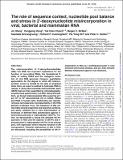| dc.contributor.author | Wang, Jin | |
| dc.contributor.author | Dong, Hongping | |
| dc.contributor.author | Chionh, Yok Hian | |
| dc.contributor.author | McBee, Megan E. | |
| dc.contributor.author | Sirirungruang, Sasilada | |
| dc.contributor.author | Cunningham, Richard P. | |
| dc.contributor.author | Shi, Pei-Yong | |
| dc.contributor.author | Dedon, Peter C | |
| dc.date.accessioned | 2017-02-02T15:45:59Z | |
| dc.date.available | 2017-02-02T15:45:59Z | |
| dc.date.issued | 2016-06 | |
| dc.date.submitted | 2016-06 | |
| dc.identifier.issn | 0305-1048 | |
| dc.identifier.issn | 1362-4962 | |
| dc.identifier.uri | http://hdl.handle.net/1721.1/106823 | |
| dc.description.abstract | The misincorporation of 2′-deoxyribonucleotides (dNs) into RNA has important implications for the function of non-coding RNAs, the translational fidelity of coding RNAs and the mutagenic evolution of viral RNA genomes. However, quantitative appreciation for the degree to which dN misincorporation occurs is limited by the lack of analytical tools. Here, we report a method to hydrolyze RNA to release 2′-deoxyribonucleotide-ribonucleotide pairs (dNrN) that are then quantified by chromatography-coupled mass spectrometry (LC-MS). Using this platform, we found misincorporated dNs occurring at 1 per 10[superscript 3] to 10[superscript 5] ribonucleotide (nt) in mRNA, rRNAs and tRNA in human cells, Escherichia coli, Saccharomyces cerevisiae and, most abundantly, in the RNA genome of dengue virus. The frequency of dNs varied widely among organisms and sequence contexts, and partly reflected the in vitro discrimination efficiencies of different RNA polymerases against 2′-deoxyribonucleoside 5′-triphosphates (dNTPs). Further, we demonstrate a strong link between dN frequencies in RNA and the balance of dNTPs and ribonucleoside 5′-triphosphates (rNTPs) in the cellular pool, with significant stress-induced variation of dN incorporation. Potential implications of dNs in RNA are discussed, including the possibilities of dN incorporation in RNA as a contributing factor in viral evolution and human disease, and as a host immune defense mechanism against viral infections. | en_US |
| dc.description.sponsorship | National Institutes of Health (U.S.) (Grant ES022858) | en_US |
| dc.description.sponsorship | Singapore. National Research Foundation | en_US |
| dc.description.sponsorship | Singapore-MIT Alliance for Research and Technology | en_US |
| dc.language.iso | en_US | |
| dc.publisher | Oxford University Press | en_US |
| dc.relation.isversionof | http://dx.doi.org/10.1093/nar/gkw572 | en_US |
| dc.rights | Creative Commons Attribution 4.0 International License | en_US |
| dc.rights.uri | http://creativecommons.org/licenses/by/4.0/ | en_US |
| dc.source | Oxford University Press | en_US |
| dc.title | The role of sequence context, nucleotide pool balance and stress in 2′-deoxynucleotide misincorporation in viral, bacterial and mammalian RNA | en_US |
| dc.type | Article | en_US |
| dc.identifier.citation | Wang, Jin et al. “The Role of Sequence Context, Nucleotide Pool Balance and Stress in 2′-Deoxynucleotide Misincorporation in Viral, Bacterial and Mammalian RNA.” Nucleic Acids Research 44.18 (2016): 8962–8975. | en_US |
| dc.contributor.department | Massachusetts Institute of Technology. Center for Environmental Health Sciences | en_US |
| dc.contributor.department | Massachusetts Institute of Technology. Department of Biological Engineering | en_US |
| dc.contributor.mitauthor | Dedon, Peter C | |
| dc.relation.journal | Nucleic Acids Research | en_US |
| dc.eprint.version | Final published version | en_US |
| dc.type.uri | http://purl.org/eprint/type/JournalArticle | en_US |
| eprint.status | http://purl.org/eprint/status/PeerReviewed | en_US |
| dspace.orderedauthors | Wang, Jin; Dong, Hongping; Chionh, Yok Hian; McBee, Megan E.; Sirirungruang, Sasilada; Cunningham, Richard P.; Shi, Pei-Yong; Dedon, Peter C. | en_US |
| dspace.embargo.terms | N | en_US |
| dc.identifier.orcid | https://orcid.org/0000-0003-0011-3067 | |
| mit.license | PUBLISHER_CC | en_US |
